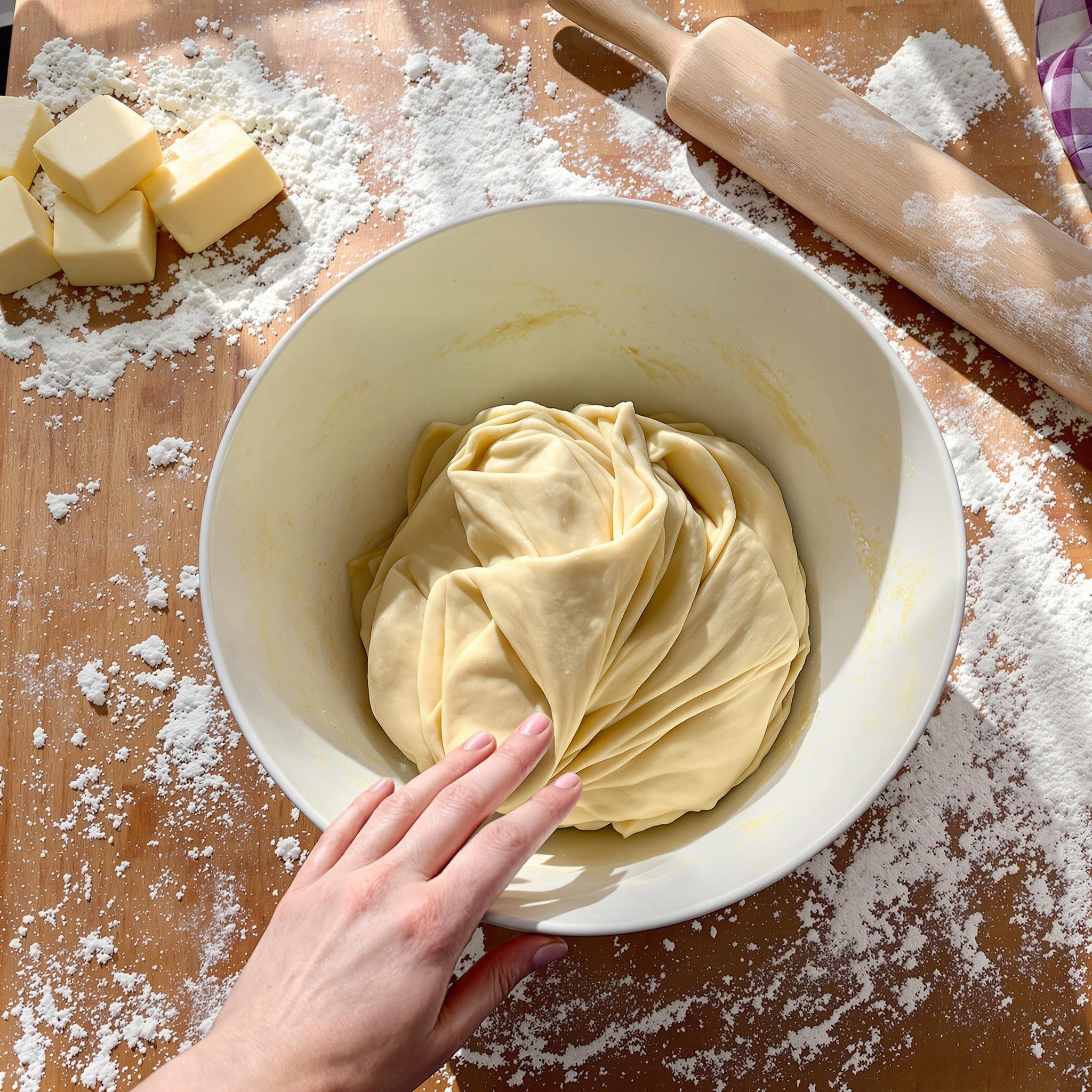Introduction to Croissant Dough: Master the Art of Perfect Pastry!
Croissant dough is pure magic. It’s buttery, flaky, and downright irresistible. I first made it on a lazy Sunday morning. The kitchen smelled incredible, and my family couldn’t stop talking about how good it was. Once you nail this recipe, you’ll want to bake it over and over.
The Story Behind Croissant Dough
Croissants started in 19th-century Austria but became famous in France. The French mastered layering butter into dough to create those airy, golden layers. Nowadays, they’re a breakfast favorite worldwide. Whether plain or filled, croissants bring happiness with every bite.
Why You’ll Love This Recipe
This recipe is simple but rewarding. The dough is easy to make, and the results are bakery-level. Plus, the smell of fresh-baked croissants is unbeatable. Perfect for beginners and experienced bakers alike.
Perfect Occasions to Prepare Croissant Dough
Make them for weekend brunches, holiday mornings, or special occasions. Serve warm with coffee for a cozy treat. They’re also great for gifting or impressing guests.
Ingredients for Croissant Dough
- All-purpose flour
- Unsalted butter
- Sugar
- Salt
- Yeast
- Milk
- Water
Substitution Options
Swap all-purpose flour with bread flour for extra chewiness. Use plant-based milk if you’re dairy-free. For a vegan version, replace butter with margarine or coconut oil.
Step 1: Mixing Dry Ingredients
Start by mixing flour, sugar, salt, and yeast in a bowl. These form the base. Sugar feeds the yeast, helping it rise. Mix until blended. Pro tip: Use a whisk to avoid lumps.
Step 2: Combining Wet Ingredients
In another container, mix milk and water. Warm it slightly—just lukewarm. Add this to the dry ingredients. The warmth activates the yeast. Stir gently until a shaggy dough forms.
Step 3: Kneading the Dough
Knead the dough on a floured surface until smooth and elastic. This builds gluten, giving structure. Knead for 8-10 minutes. Let it rest in a warm spot for two hours. Watch it double in size.
Step 4: Layering with Butter
Roll out the risen dough into a rectangle. Place chilled butter on one half, then fold the other half over like a book. Roll and fold several times to create layers. This traps air, making the pastry light and flaky.
Step 5: Shaping the Croissants
Chill the dough before shaping it into crescents. Cut triangles, then roll each one tightly. Leave space between them on the baking sheet. Let them proof until puffy before baking.
Chef’s Tip
Keep your butter cold but pliable. Too hard, and it won’t spread evenly. Too soft, and it’ll melt into the dough. Aim for a texture like playdough.
Time Required
- Prep Time: 30 minutes
- Rising Time: 2 hours
- Chilling Time: 1 hour
- Baking Time: 15-20 minutes
- Total Time: About 4 hours
Nutritional Information
Per serving (1 croissant): Calories: 250, Protein: 5g, Fat: 12g, Carbs: 30g.
Extra Information
Fun fact: “Croissant” means crescent in French. Its shape comes from Turkish flags during Vienna’s history.
Necessary Tools
- Large mixing bowl
- Rolling pin
- Parchment paper
- Baking sheet
- Pastry brush (for egg wash)
Storage Instructions
Store leftovers in an airtight container at room temperature for up to two days. For longer storage, freeze them wrapped in foil. Reheat frozen croissants in the oven for 5-7 minutes to restore crispness.
Avoid refrigerating as it dries them out. Room temperature keeps their texture intact.
To refresh stale ones, sprinkle lightly with water and warm briefly in the oven.
Tips and Tricks
- Use high-quality butter for the best flavor.
- Don’t rush chilling steps—they’re key to flakiness.
- Brush tops with egg wash before baking for a glossy finish.
Serving Suggestions
- Serve plain with coffee or tea.
- Fill with ham and cheese for a savory twist.
Healthier Alternatives for Croissant Dough
Here are six variations to try:
- Whole Wheat Croissants: Replace half the flour with whole wheat for added fiber.
- Low-Fat Version: Reduce butter and add Greek yogurt for moisture.
- Vegan Croissants: Use plant-based butter and almond milk.
- Sugar-Free Option: Substitute sugar with stevia or monk fruit.
- Gluten-Free Adaptation: Use a gluten-free flour blend.
- Herb-Infused Savory Croissants: Add rosemary or thyme to the dough.
Common Mistakes to Avoid
Mistake 1: Overworking the Dough
Over-kneading makes the dough tough. Stop once it feels smooth and elastic. Set a timer to prevent overdoing it.
Mistake 2: Skipping Chilling Steps
Skipping chilling causes butter to melt unevenly. Always chill after folding to keep layers distinct.
Mistake 3: Rolling Too Thin
Rolling too thin weakens the structure. Aim for even thickness throughout. Practice helps here.
Mistake 4: Underproofing
Underproofed croissants stay dense. Let them rise until noticeably puffy before baking.
Mistake 5: Baking at Wrong Temperature
Baking at low heat prevents proper browning. Preheat your oven to 400°F (200°C) for golden results.
Frequently Asked Questions
Can I make croissant dough ahead?
Yes! Make the dough a day in advance and store it in the fridge. Bring it to room temp before shaping.
How do I know when the dough has risen enough?
It should double in size and feel springy to the touch. Patience pays off here.
What if my layers don’t separate?
This happens if the butter melts into the dough. Chill longer next time and handle gently.
Can I freeze shaped croissants?
Absolutely! Freeze unbaked croissants on a tray, then transfer to bags. Bake directly from frozen.
Why does my dough taste yeasty?
Too much yeast can overpower the flavor. Stick to the recommended amount for balance.
Do I need a stand mixer?
Nope! Hand-kneading works just fine. It’s more hands-on but equally effective.
How do I get a shiny crust?
Brush the tops with beaten egg mixed with a splash of water before baking.
Can I use salted butter?
Yes, but reduce added salt to avoid oversalting.
Why are my croissants dense?
Dense croissants result from underproofing or overhandling. Allow ample rise time and gentle folds.
Is it okay to skip sugar?
Yes, especially for savory versions. Sugar enhances browning, though, so adjust expectations.
Conclusion
Mastering croissant dough takes practice, but the rewards are worth it. With these tips, tricks, and detailed steps, you’re ready to create bakery-quality pastries at home. Enjoy every flaky, buttery bite!

Equipment
- Large mixing bowl
- Rolling pin
- Parchment paper
- Baking sheet
- Pastry brush for egg wash
Ingredients
- 500 g all-purpose flour
- 300 g unsalted butter chilled
- 50 g sugar
- 10 g salt
- 10 g yeast
- 250 ml milk lukewarm
- 250 ml water lukewarm
Instructions
- Mix flour, sugar, salt, and yeast in a large bowl.
- Combine milk and water in another container, warm slightly and add to dry ingredients.
- Knead the dough until smooth and elastic, about 8-10 minutes, then let rise for 2 hours.
- Roll out the dough, place butter on one half, fold, and roll to create layers.
- Shape into crescents, proof, and then bake.


